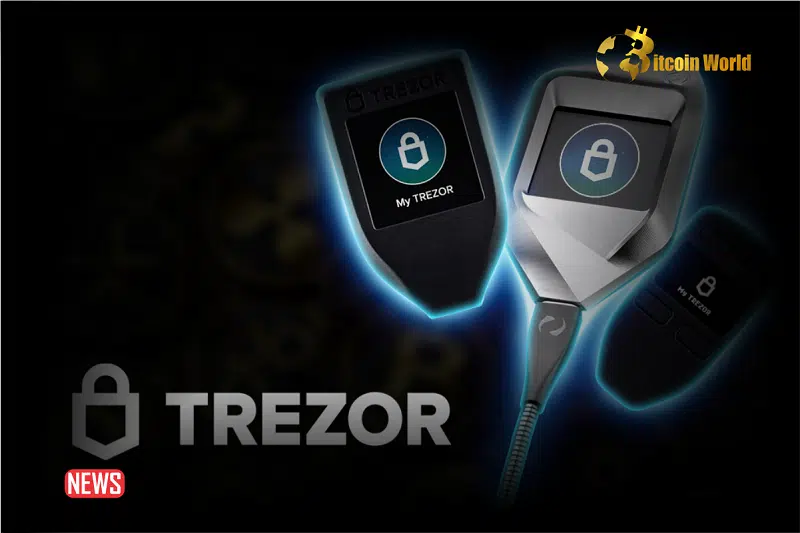In the world of cryptocurrency, where self-custody and security are paramount, even the most trusted names can face challenges. Trezor, a leading hardware wallet provider renowned for its security features, recently announced a security incident that has sent ripples through the crypto community. If you’re a Trezor user, or anyone concerned about keeping your digital assets safe, this is crucial information you need to know.
What Exactly Happened at Trezor?
On Saturday, January 20th, Trezor disclosed that they were investigating a security breach affecting their third-party customer support platform. Imagine the platform you go to when you have questions about your Trezor device – that’s where the unauthorized access occurred.
Here’s a quick breakdown of the key points:
- Security Breach on Support Platform: Trezor’s customer support ticketing portal, managed by a third-party vendor, was compromised.
- Data Exposure: An unauthorized party gained access to personal data of approximately 66,000 Trezor customers.
- Affected Users Contacted: Trezor has stated that all affected customers have been notified about the breach.
- Timing of the Breach: The incident took place in the late hours of January 17th.
Which Trezor Users Are Impacted?
According to Trezor’s official statement, the breach targeted customer data from individuals who had interacted with their support page since December 2021. If you’ve reached out to Trezor support for any reason in the past couple of years, your information might be among those exposed. Specifically, if you’ve used the Trezor Support page, pay close attention to any communications from Trezor and be extra vigilant about potential phishing attempts.
What Kind of Data Was Exposed? Is My Crypto at Risk?
This is the question on everyone’s mind. Trezor has clarified that the exposed data was limited to:
- Email Addresses: Your email address associated with your Trezor support interactions.
- Name/Nickname: The name or nickname you might have used when contacting support.
Crucially, Trezor has emphasized that no user funds were compromised as a direct result of this incident. The breach did not involve access to wallet recovery seeds, private keys, or any information that could directly lead to the loss of your cryptocurrency holdings. This is a significant relief, but the story doesn’t end here.
The Phishing Threat: Why This Breach Still Matters
While your crypto assets are safe from direct theft due to this breach, the exposed data opens the door to a different, but equally dangerous threat: phishing attacks.
Think about it – malicious actors now have a list of 66,000 individuals confirmed to be Trezor hardware wallet users. This is a highly targeted and valuable list for phishing scams. Trezor has reported that the perpetrators have already started contacting users, attempting to trick them into revealing sensitive information, particularly their recovery seeds.
What is a recovery seed and why is it so critical?
Your recovery seed (or seed phrase) is a set of 12 or 24 words that acts as the master key to your hardware wallet. It’s essentially the backup of your entire crypto wallet. Anyone who gains access to your recovery seed can control all the cryptocurrency associated with that wallet. It’s the holy grail for crypto thieves.
Here’s how the phishing scam might work:
- Official-Looking Emails: Scammers might send emails that look like they are from Trezor, using official logos and branding.
- Urgent Warnings: These emails might create a sense of urgency, claiming your account is at risk or needs immediate verification due to the security breach.
- Requests for Sensitive Information: The emails will attempt to trick you into clicking a link that leads to a fake website, where you will be asked to enter your recovery seed, password, or other sensitive details.
Remember: Trezor will NEVER ask for your recovery seed. Your recovery seed should NEVER be entered online, shared with anyone, or stored digitally.
What is Trezor Doing About It?
Trezor has taken several steps to address the security breach and mitigate further risks:
- Notifying Affected Users: As mentioned, Trezor has contacted all 66,000 affected customers to inform them about the breach and warn them about potential phishing attempts.
- Internal Audit: Trezor conducted an internal audit to understand the scope of the breach and identify the exposed data.
- Working with Third-Party Vendor: Trezor is collaborating with the third-party vendor responsible for the support platform to investigate the incident and enhance security measures.
- Monitoring and Warnings: Trezor is actively monitoring for phishing attempts and issuing warnings to its user base through blog posts and social media channels.
See Also: Rocket Pool X Account Hacked, Hackers Reported False Smart Contract Exploit
How Can You Protect Yourself? Actionable Steps for Trezor Users (and All Crypto Owners)
This incident serves as a critical reminder of the constant need for vigilance in the crypto space. Here are actionable steps you can take to protect yourself:
- Be Extremely Cautious of Emails: Treat every email claiming to be from Trezor (or any crypto service) with extreme skepticism. Never click on links in emails that ask for sensitive information. Always navigate directly to the official Trezor website by typing the address into your browser.
- Verify Communication Channels: If you receive a communication that seems suspicious, verify it through official Trezor channels. Check their official website, blog, or social media for announcements.
- Enable Phishing Protection: Utilize browser extensions and email filters that help detect and block phishing attempts.
- Educate Yourself About Phishing: Learn to recognize the common tactics used in phishing scams. Be aware of red flags like urgent language, requests for personal information, and suspicious links.
- Use Strong Security Practices: Beyond this specific incident, always practice strong crypto security habits: use strong passwords, enable two-factor authentication wherever possible, and keep your software updated.
- Remember the Golden Rule: NEVER share your recovery seed with anyone, under any circumstances.
Is Trezor Still Safe?
Despite this security breach, Trezor hardware wallets themselves remain a secure way to store your cryptocurrency. The breach was on a third-party support platform, not on the core Trezor device security. Trezor has acted promptly to address the situation and is taking steps to prevent future incidents. However, this event underscores the importance of constant vigilance and the ever-present threat of social engineering and phishing in the crypto world.
Key Takeaway: Stay Vigilant!
The Trezor security breach is a stark reminder that even in the seemingly secure world of hardware wallets, data security and user awareness are paramount. While no funds were directly stolen, the exposure of customer data creates a window of opportunity for phishing attacks. By staying informed, being cautious, and following best security practices, you can significantly reduce your risk and keep your crypto assets safe. Always remember to be skeptical, verify information through official channels, and never, ever share your recovery seed.
Disclaimer: The information provided is not trading advice, Bitcoinworld.co.in holds no liability for any investments made based on the information provided on this page. We strongly recommend independent research and/or consultation with a qualified professional before making any investment decisions.


